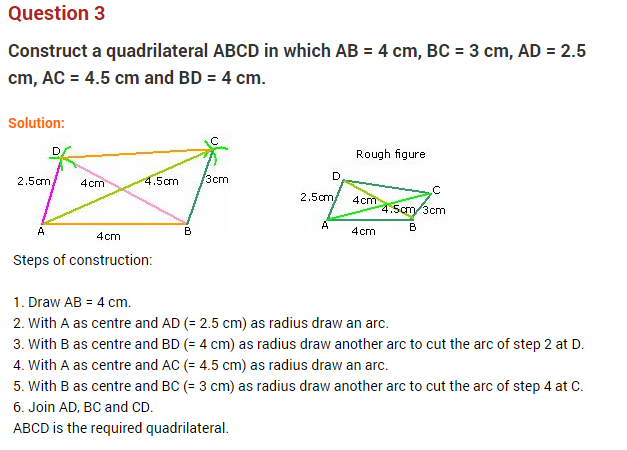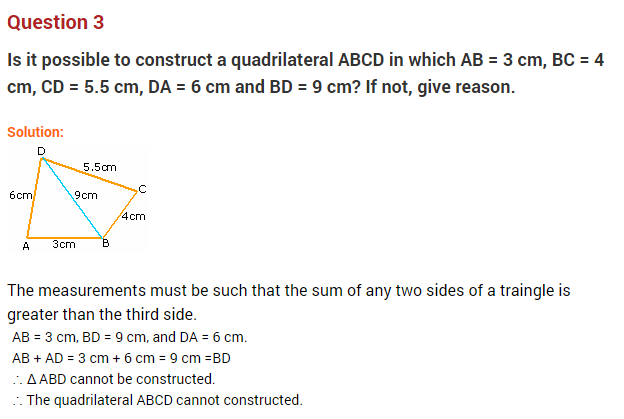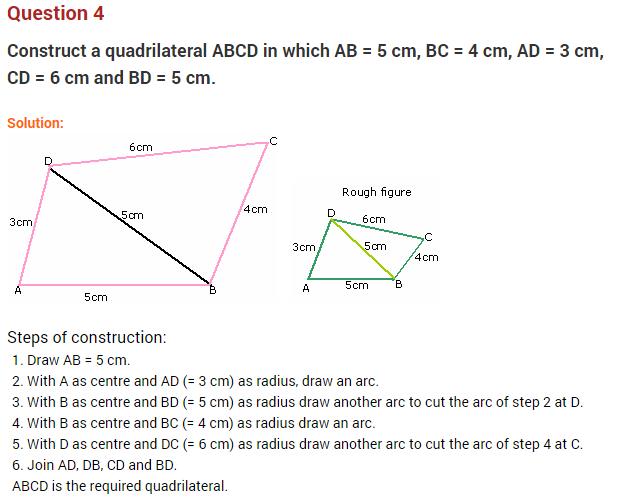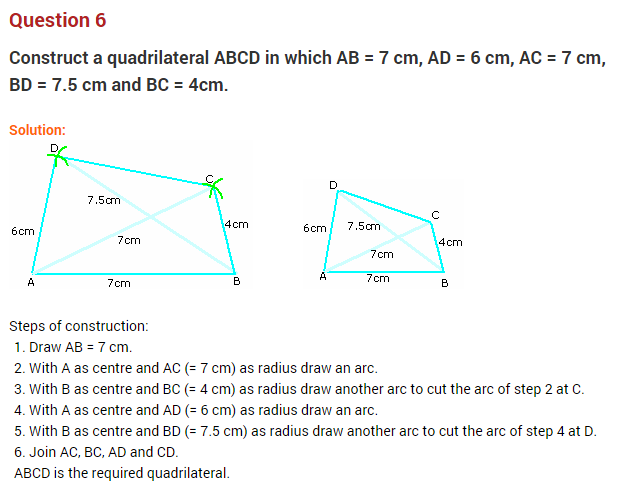Practical Geometry Class 8 Extra Questions Maths Chapter 4
Extra Questions for Class 8 Maths Chapter 4 Practical Geometry
Question 1.
Construct a quadrilateral PQRS, given that QR = 4.5 cm, PS = 5.5 cm, RS = 5 cm and the diagonal PR = 5.5 cm and diagonal SQ = 7 cm.

Solution:
Construction:
Step I: Draw QR = 4.5 cm.
Step II: Draw an arc with centre R and radius 5 cm.
Step III: Draw another arc with centre Q and radius 7 cm to meet the previous arc at S.
Step IV: Join RS and QS.
Step V: Draw two arcs with centre S and R and radius 5.5 cm each to meet each other at P.
Step VI: Join RP, SP and PQ.
Thus PQRS is the required quadrilateral.
Question 2.
Construct a quadrilateral ABCD in which AB = 4 cm, BC = 3.5 cm, CD = 5 cm, AD = 5.5 cm and ∠B = 75°.

Solution:
Construction:
Step I: Draw AB = 4 cm.
Step II: Draw an angle of 75° at B and cut BC = 3.5 cm.
Step III: Draw an arc with centre C and radius 5 cm.
Step IV: Draw another arc with centre A and radius 5.5 cm to meet the previous arc at D.
Step V: Join CD and AD.
Thus ABCD is the required quadrilateral.
Question 3.
Construct a square whose side is 5 cm.

Solution:
Construction:
Step I: Draw AB = 5 cm.
Step II: Draw an angle of 90° at B and cut BC = 5 cm.
Step III: Draw two arcs with centre A and C and same radii of 5 cm which meet each other at D.
Step IV: Join AD and CD.
Thus, ABCD is the required square.
Question 4.
Construct a rhombus ABCD in which AB = 5.8 cm and AC = 7.5 cm.

Solution:
Construction:
Step I: Draw AB = 5.8 cm.
Step II: Draw an arc with centre B and radius 5.8 cm.
Step III: Draw another arc with centre A and radius 7.5 cm to meet the previous arc at C.
Step IV: Draw two arcs with centres A and C and of the same radius 5.8 cm to meet each other at D.
Step V: Join BC, AC, CD and AD.
Thus ABCD is the required rhombus.
Question 5.
Construct a rhombus whose diagonals are 6 cm and 8 cm.

Solution:
Construction:
Step I: Draw SQ = 8 cm.
Step II: Draw a right bisector of SQ at O.
Step III: Draw two arcs with centre O and radius 3 cm each to cut the right bisector at P and R.
Step TV: Join PQ, QR, RS and SP.
Thus PQRS is the required rhombus.
Question 6.
Construct a rectangle whose diagonal is 5 cm and the angle between the diagonal is 50°.


Solution:
Construction:
Step I: Draw AC = 5 cm.
Step II: Draw the right bisector of AC at O.
Step III: Draw an angle of 50° at O and product both sides.
Step IV: Draw two arcs with centre O and of the same radius 2.5 cm to cut at B and D.
Step V: Join AB, BC, CD and DA.
Thus, ABCD is the required rectangle.
Question 7.
Construct a quadrilateral ABCD in which BC = 4 cm, ∠B = 60°, ∠C = 135°, AB = 5 cm and ∠A = 90°.

Solution:
Construction:
Step I: Draw AB = 5 cm.
Step II: Draw the angle of 60° at B and cut BC = 4 cm.
Step III: Draw an angle of 135° at C and angle of 90° at A which meet each other at D.
Thus, ABCD is the required quadrilateral.
Question 8.
Construct a parallelogram ABCD in which AB = 5.5 cm, AC = 7 cm and BD = 8 cm.

Solution:
Construction:
Step I: Draw AB = 5.5 cm.
Step II: Draw an arc with centre B and radius \(\frac { 8 }{ 2 }\) cm = 4 cm.
Step III: Draw another arc with centre A and radius \(\frac { 7 }{ 2 }\) cm = 3.5 cm which cuts the previous arc at O.
Step IV: Join AO and produce to C such that AO = OC.
Step V: Join BO and produce to D such that BO = OD.
Step VI: Join BC, CD and AD.
Thus ABCD is the required parallelogram.
Question 9.
Construct a rhombus PAIR, given that PA = 6 cm and angle ∠A = 110°.
Solution:
Since in a rhombus, all sides are equal, so PA = AI = IR = RP = 6 cm
Also, rhombus is a parallelogram
so, adjacent angle, ∠I = 180° – 110° = 70°

Steps of construction
Step I. Draw AI = 6 cm
Step II. Draw ray \(\bar { AX }\) such that ∠IAX = 110° and draw \(\bar { IY }\) such that ∠AIY = 70°.
Step III. With A and I as centres and radius 6 cm draw arcs intersecting AX and IY at P and R respectively.
Step IV. Join PR.
Thus, PAIR is the required rhombus.



















